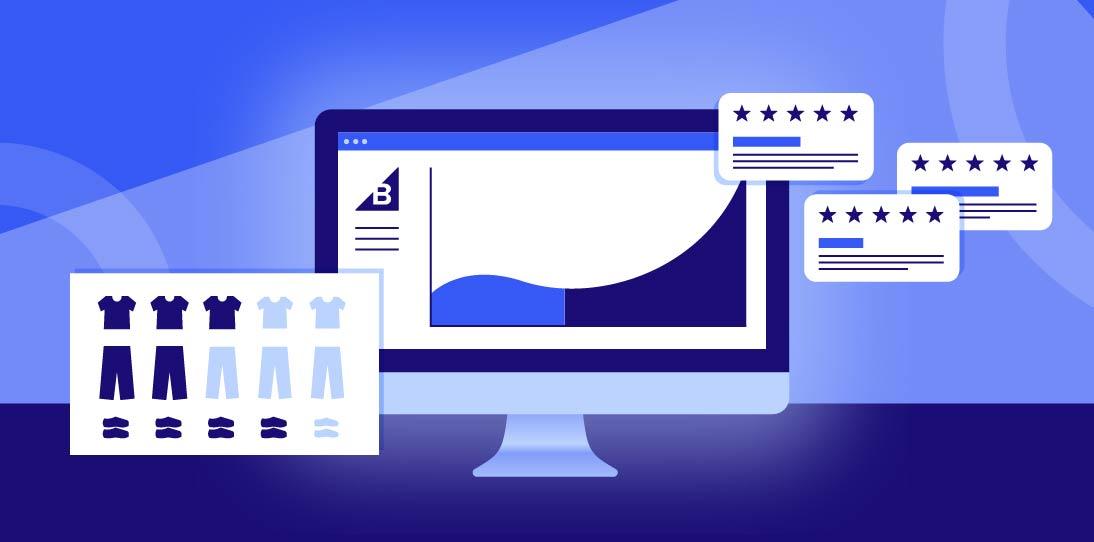- Enterprise
- Essentials
Grocery Ecommerce: How to Run a Successful Online Store

Create Your Own Store and Start Selling Today
As humans, food and nutrition are the backbones of our wellbeing. So it’s no surprise that the topic of grocery ecommerce is gaining interest and importance.
In fact, a study from Mercatus predicts that grocery ecommerce sales will surpass 20% of the total U.S. grocery market in 2026.
Over the last few years, an increasing number of people have discovered the benefits of online shopping — food selection, ease of dietary management and product accessibility, to name a few.
According to research from McKinsey, grocery ecommerce is the top COVID-era trend that is likely to be permanent. There are a few practical reasons why.
For one, there’s a general concern around health and wellness. Even though societies are moving forward from the COVID-19 pandemic, some people prefer to stay at home. Other people simply enjoy the variety of food available for purchase online.
Another factor is the global supply chain — in some cases, it may be easier to get important items online rather than in local supermarkets.
No matter the reason, now is a good time for retailers to start thinking about moving their operations online. With the shifts taking place in the economy, some first-time entrepreneurs may also be thinking about starting an ecommerce food brand.
Here are some of the building blocks you’ll need to be successful in your efforts to increase online grocery sales:
Prioritizing Fulfillment as a Core Strategy
The general challenge.
When launching your grocery ecommerce brand, the biggest question you need to ask is how you’ll get products in the hands of your customers.
First and foremost, you’ll need a firm handle on compliance regulations — both in terms of where your store is doing business and where you deliver your products.
For instance, if you’re located in the United States, you may come to a realization that you can’t ship your products to Canada and Mexico for legal reasons
It is a good idea to work with a legal or regulatory expert in the food industry to determine the needs for your specific products and brand. At some point, you’ll need to consult this expertise when figuring out your product packaging.
Beyond bare minimum food laws, you should expect to encounter supply chain challenges. In general, shipping companies are experiencing delays. Keeping this context in mind, some shipping analysts recommend that grocery retailers shorten their supply chains and optimize towards home deliveries.
“Local systems with fewer steps between the grower and the consumer often support organic and sustainable farms, which are committed to paying fair wages and are more community-driven and diverse,” explains Moya Kneafsey, professor in food and local development at Coventry University in an interview with BBC.
Overview of fulfillment approaches.
Every ecommerce grocer is unique, which means your product fulfillment strategy is unique, too. As you begin your research, it’s helpful to get familiar with the following concepts:
Site-to-store pickup.
If you operate a physical storefront, you can encourage your customers to pick up their items directly in-store, or offer curbside pickup. To create this functionality, you’ll need an ecommerce platform that integrates with your order and inventory management system, along with your on-the-ground customer service operations. At a minimum, this software needs to support a smooth process for customers to buy items online or through a mobile app and pick them up in stores.
Direct delivery.
If you’re looking to deliver products directly to your customers’ doorsteps, you’ll need to work with a shipping and logistics provider that understands the compliance requirements for what you’re selling in your store. As you evaluate solutions for grocery delivery, an important question to ask potential shipping partners is their protocol for handling perishables and other items that you are selling. As a merchant, you are ultimately responsible for the integrity and condition of your product.
Local food delivery services.
This option is ideal for local businesses, especially restaurants and specialty shops, with an ecommerce component. Depending on the geographies that you serve, there may be unique options nearby for delivering fresh items to customers, such as Instacart or Uber Eats. Yelp and Google — in addition to referrals from fellow business owners in your area — are good places to start.
Micro-fulfillment centers.
There’s a growing movement of small, automated warehouse centers in urban locations, often called “dark stores.”
According to CBInsights, a leading firm that examines insights in technology, this trend is in response to the increasing expectations around 2 day delivery. You can think of micro-fulfillment centers as hubs for creating delivery efficiencies. Micro-fulfillment centers help retailers improve their operations with respect to the following, CBInsights explains:
- Localized data and inventory.
- Picking and packing.
- Last-mile delivery.
- Expansion.
The idea is to tap into technology, resources and expertise to be able to compete on the same footing as the Amazons and Walmarts of the world.
Additional thoughts about fulfillment.
Beyond the quality and presentation of your products, fulfillment is the heartbeat of your grocery ecommerce operations. You need a straightforward, cost-effective and seamless path to get items into the hands of your customers.
As you dive into fulfillment options and best practices, you’ll begin to discover an entire world of configurations, research and technologies. The key is to minimize costs while ensuring the best possible customer experience.
Once you do some digging, you’ll recognize a range of options for achieving this goal. If you’re operationally minded, you may also find the fulfillment puzzle to be fun.
Launch your Ecommerce Store
Create your own store and start selling today with our risk-free trial.
Start Your Free TrialConsiderations for Grocery Ecommerce Success
It takes passion and creativity to build a successful online food store. But it’s equally important to have the right technical infrastructure and foundations in place. Just think about how many moving parts exist in a food business — next time you go to the grocery store, take a moment to observe everything that’s happening behind the scenes.
When you create an online grocery business, there are additional complexities that come up. Software can take some of the hard work out of the equation.
Choosing technology.
With grocery ecommerce, success comes down to speed and efficiency. That’s why it’s important to choose software that operates as a central business hub.
As an example, consider the story of Lammes Candies, which is a 135-year-old business that created an online storefront.
“When we were considering a new platform, the partner ecosystem was very important because we didn't want to find ourselves stranded on our own island,” explains Lauren Cevallos, Lammes Candies Ecommerce & Mail Order Manager.
“We knew site development was going to be tricky because we were anticipating lots of customizations, and there was a very small network of partners who could actually work with us and our code.”
Technology enables the team at Lammes Candies to adapt to a variety of situations ranging from bulk orders from corporate buyers to implementing loyalty programs for repeat customers.
High-level technology components.
Here are some of the most important technology considerations that you’ll need to make:
Products and stock.
Where are you going to store your items, and how will you keep track of your inventory? How can software help you manage your merchandise? How can you use software to manage storage conditions remotely? Your software needs to give you an accurate and direct view of your merchandise.
Order fulfillment.
If your goal is to build a scalable ecommerce operation, you need to be able to fulfill online orders quickly and maintain clear communication with those placing orders.
“Now we’re entering a new phase where we can focus less on the manual work of putting orders in the system, and more on optimization, reaching new customers, and exploring different marketing opportunities,” says Cevallos in an interview with BigCommerce. “This coming year, we’d love to double our volume, and it’s looking good because we’re finally on a stable platform.”
Customer service.
If you’re in the grocery industry, it’s expected that you’ll encounter questions from shoppers. Not to mention, you’ll also need a structured way to address concerns. Meal-planning is one of the most personalized aspects of a person’s life — there are many dietary requirements and restrictions out there.
For this reason, your grocery ecommerce business needs to offer best-in-class customer service. At the very least, even if you can’t provide immediate responses to questions, it will be important to maintain a channel for fielding questions and concerns. Technology can help.
User experience.
Your website needs to be easy to navigate while simultaneously creating a delightful experience. Keep in mind that people have varying levels of comfort with shopping online — that it’s up to your company’s ecommerce team and technology to build a magnetic brand. Remember that an online grocery shopping experience needs to convey a feeling beyond the bare minimum of being practical and transactional.
“We know that we’ve got to make our online experience as similar and consistent as we can to the experience you have in the store,” says Burg. “It makes our customer feel like we’re with you along the way in your purchasing process and we’re here to help.”
The importance of integrations.
To run a grocery ecommerce storefront, you need software that cooperates well with different types of technology. Most likely, you’ll be working with a suite of applications to accomplish your specific business goals.
Luckily, BigCommerce offers a variety of apps and integrations to help you get your ecommerce store up and running.
These apps and integrations include, but are not limited to:
- Channel Grabber for order processing and shipping integration.
- Google Shopping to drive more shoppers to its BigCommerce store by seamlessly connecting to Google, Bing, Facebook and Instagram.
- Zakeke to allow customers to customize the products they purchase.
- Vend for point of sale (POS) processing to sell, track and manage inventory.
- Bevica is an enterprise resource planning (ERP) software for beverage management.
You can browse BigCommerce’s App Marketplace for technology integration ideas and examples.
Ways to Improve the Customer Experience
The online grocery landscape is competitive — remember that human attention spans are becoming shorter, and competitor products are a simple Google Search away. Amazon and Whole Foods are also capturing wallet-share, which creates pressures on smaller retailers and specialty food brands.
The simplest way to counteract these market forces is to create a strong foundation for a smooth customer experience.
Tips to become a trusted and recognized food brand.
Here’s what your ecommerce team will need to consider.
Prioritize quality over quantity.
Keep in mind that plenty of businesses find success in specializing in a few niche items. By prioritizing quality above quantity, merchants can prioritize the details that matter — writing detailed product descriptions, making sure that ingredient information is easy to find, and ensuring high-quality fulfillment practices, to name a few.
Focus on food safety.
The topic of food safety is gaining importance for ecommerce businesses — especially in the United States. The Food and Drug Administration (FDA) is in the process of developing regulatory standards for merchants who specialize in selling food online. Here are some questions that the FDA recently navigated at a local policy summit:
“What more can be done to prevent food tampering? How do we ensure that foods are labeled with the information consumers need, particularly when ingredients contain allergens or gluten? And how do we empower consumers with the resources they need to recognize safety issues when the food arrives?”
Depending on where your store is located and where you plan to ship products, there may be local regulations to follow as well.
Beyond regulations, inspections and compliance, your customers will value knowing that you keep their safety top of mind. The small details matter.
Partner with other retailers.
If you’ve created an amazing product, you may be considering selling it through online channels beyond your own store. Amazon is one platform that comes to mind. In addition, other major retailers may begin to take interest in carrying your product.
There are pros and cons to partnering with retailers. The biggest benefit is that your brand will potentially gain exposure to more digital foot traffic and a wider audience. The drawback is that customers will be buying your products elsewhere on the internet — it will be more of a challenge to attract audiences to your website.
For this reason, it’s important to give careful consideration to your packaging. Let’s say, for instance, that your store’s website is part of your branding. With this approach, grocery shoppers may discover your products for the first time through a retail partner and then become a loyal customer to your store.
Be strategic about payments.
What types of payments does your online store accept? For many shoppers, this question is critical as to whether they are able to follow through with a purchase.
Research has found that shopping cart abandonment hovers around 70%. In other words, when the time comes to transact, only 3 in 10 shoppers will follow through with checkout.
To encourage more transactions, merchants need to put themselves in the shoes of their customers. Beyond accepting credit cards, for instance, you may choose to accept PayPal or a service like Affirm that allows shoppers to pay monthly for bulk grocery orders.
The key is to make your store’s payments process as seamless as possible. BigCommerce currently offers more than 65 pre-integrated online payment solutions, serving 230 countries and more than 140 currencies. You can learn more about these payment options here.
Grocery Ecommerce Marketing Ideas
Once you’ve established your grocery ecommerce foundation, the next step is to build up your customer base. That process requires hard work, dedication, and strategic thinking.
There are no shortcuts. Rather, envision that you’re building relationships with your audience at scale. That means thinking through a long-term marketing strategy that communicates a consistent brand message.
Marketing fundamentals.
Your marketing and branding strategy are inextricably linked. Your brand is your online identity that consists of your visual system, in addition to the story you put out into the world. With these fundamentals in place, you will be well-positioned to build your distribution engine.
Here are some of the components to think through when building up your marketing program.
1. Start with your loyalty program.
Among marketers, it’s well-known that repeat customers are more valuable than repeat buyers. According to marketing automation provider Constant Contact, repeat customers spend more money, are easier to sell to, and are more efficient to acquire. Research from Bain and Company has found that increasing customer loyalty by just 5 percent translates into a 75% increase in profitability, on average.
One example to reference is Lammes Candies, which has focused on loyalty as a core marketing strategy to increase sales volume. This approach involves recommendations for gift ideas, an active presence on instagram, user generated photos and reviews.
Beyond the basics of building a loved brand and social experience, an important strategy is to reward customers for their purchases — through a point system, for instance — to encourage repeat purchases. If you’re looking for more information, here’s a video that can help you find rewards through customer groups:
2. Incorporate subscription plans.
One way to encourage repeat purchases is to launch a monthly program around your products. A simple idea is a regular subscription that customers can start and stop at any time. The benefit is clear — consistency.
The key is to create a value proposition that your customers will fully enjoy. For instance, you could send a sampler box with new items to try each month — or, you could introduce subscribers to new pairings (chocolate and wine).
3. Create an omnichannel digital marketing plan.
Simply, “omnichannel” means that you are using multiple marketing pathways to reach your target audience. For example, you can run pay-per-click advertising campaigns on platforms like Facebook, Twitter, and Instagram.
With a solid brand messaging and design strategy in place, your food brand will be in a strong position to reach customers in-the-moment, with a memorable and consistent storyline. Remember — it’s not about what you say, but rather, what your audience remembers.
Create Your Beautiful Store Today
Start your free 15-day trial, no credit card required.
Start Your Trial NowThe Final Word
One of the biggest challenges, you’ll notice, when starting an ecommerce company is that the grocery market seems saturated with bigger players. This fact is undeniable — established grocery chains and consumer packaged goods (CPG) companies have a major competitive advantage due to the resources available to them.
No matter the competition, don’t get discouraged. When it comes to food, people crave variety and diversity. There’s always room to bring something new to the table. With the rise of ecommerce, you can build a brand that reaches people everywhere.
This material does not constitute legal, professional or financial advice and BigCommerce disclaims any liability with respect to this material. Please consult your attorney or professional advisor on specific legal, professional or financial matters.



